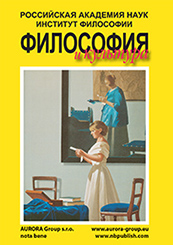Philosophy of knowledge
Reference:
Gribkov, A.A., Zelenskii, A.A. (2023). Determination of consciousness, self-consciousness and subjectness within the framework of the information concept. Philosophy and Culture, 12, 1Ц14. https://doi.org/10.7256/2454-0757.2023.12.69095
Abstract:
The article is devoted to the study of the nature of consciousness within the framework of the information concept. The paper proposes a definition of consciousness as an informational environment in which an extended model of reality is realized. The process of realization of this extended model is defined as thinking. The result of thinking is information objects that form a system in the form of information environment. Information objects are reflections of the real world properties, not directly, but by means of translation through a special object Ц a carrier of consciousness. In the case of human consciousness, such a carrier is a human being (represented in the form of his nervous system). As a result, consciousness can be qualified as a simulacrum of reality, i.e., a model of a model: an information model of the carrier of consciousness, which in turn is a means of physical modeling of the real "big" world. Possible mechanisms mediating thinking are considered. For this purpose, two new concepts are introduced: neural circuit and neurophysical pattern. An approach to the study of self-consciousness based on the localization of the consciousness carrier in the multidimensional space of states of initial real objects, as well as their reflections in the form of information objects is proposed. This localization is ensured by the presence of feedbacks. Summarizing the results of the study, the article states the following connection between consciousness, self-consciousness and subjectness: under certain conditions (when consciousness is localized in the state space of the carrier of consciousness), consciousness acquires the property of self-consciousness, a special case of which (when the initiator of changes determining localization is the carrier of consciousness) is self-consciousness endowed with subjectness.
Keywords:
self-consciousness, localization, pattern, circuit, neuron, nervous system, consciousness carrier, information medium, consciousness, subjectness
Spiritual and moral search
Reference:
Akimov, O.Y. (2023). Paradox of practical atheism in Raimund Lullus spiritual quests. Philosophy and Culture, 12, 15Ц35. https://doi.org/10.7256/2454-0757.2023.12.69200
Abstract:
The intuitions of Raimundus Lullus religious metaphysics are in this article explicated according to the opportunities of the convergence between the medieval and the new time philosophy. Such approach to the creativity of the thinker is possible, because his conception is one sides associated with the mystical symbolic theologism, that is typical for the medieval tradition, over sides develops Lullus the new understanding of the infinity of the world, inherent in the newtime philosophy. This opposition conditions some of the features of Lullus spiritual quest. This quest connected the respect to the past, that causes the homesickness to the lost ideals, together with the progressivity Ц the presentation of the future. This presentiment is by Lullus expressed as the desire to change the external world. The aim of this change is the approximation of the rational theological base Ц the model for the real life. Lullus experiences the combination and the unrealized synthesis of this intentions as the tragedy. The acute and intensive conflict of this intentions triggers the practical atheism, when the stimulation of the external distraction of the evil leads causes the appearance and the activation of the new evil. This disaster of life is determined with some aspects of Lullus metaphysics, in that the infinity of God is realized as the infinity of the world. The infinity of the world is by Lullus given as the rational hierarchical order, leading to the creator of the world. The tragedy of life is for Lullus the marker, that emphasizes the crisis of the medieval philosophy, that was based on the revelation. This crisis discovers the land of new philosophy. This philosophy stresses the autonomy of the human personality.
Keywords:
Tradition, Paradox, Autonomy, Personality, Tragedy, Life, Utopia, World, God, Culture
Social philosophy
Reference:
Ravochkin, N.N., Kachay, I.S., Petrov, M.A. (2023). Personal stories as a result of creative activity and a tool for overcoming the fragmentation of everyday life: cultural and philosophical analysis. Philosophy and Culture, 12, 36Ц47. https://doi.org/10.7256/2454-0757.2023.12.69343
Abstract:
The object of this research is the fragmented everyday life of social life practices. The subject of the research is personal stories realized in storytelling and considered as the result of the creative activity of the subject and a way to overcome the fragmentation of everyday life of modern culture. The authors consider the fragmentation of everyday life as a factor in the desocialization of the subject and the leveling of unified mechanisms of social interaction. Storytelling is defined as a way for a person to consistently present various storylines and broadcast the principles of their personal existence, creating an effect of belonging among recipients and awakening their imagination. The research substantiates that storytelling resources allow a subject to broadcast personal values, creatively express their individuality through virtual self-presentation and respond to current public demands, thereby overcoming the fragmentation of everyday life. As the conclusions of the research, the authors state that public order and social interaction are conditioned by the influence of the narratives of each subject on the foundation of their own being and the formation of a vector of development of all participants in intersubjective relations through the dissemination of the principles of personal existence in the storytelling system. The authors emphasize the creative nature of personal stories, the creation and telling of which is a prerequisite for the formation of unified principles of social existence due to the transmitted ideas about socially acceptable rules and stable patterns of behavior that become a set of rituals. The authors conclude that personal stories allow the subject to overcome fragmented everyday life, move to a qualitatively new level of normative determination, develop a strategy of self-identity and move from a separate way of being to a holistic existence in the context of intersubjective interactions.
Keywords:
social reality, social order, fragmentation of everyday life, social interaction, narrative, storytelling, personal stories, habitus, ritual, creativity
Aesthetics
Reference:
Kudaev, A.E. (2023). Berdyaev and Florence. Aesthetic Intersections. Philosophy and Culture, 12, 48Ц90. https://doi.org/10.7256/2454-0757.2023.12.39234
Abstract:
The article is devoted to Berdyaev's first Italian journey, which had a "tremendous influence" both on his creative destiny and on the development of his aesthetic views. It is significant that one of the defining motives for visiting Italy was his desire to "return to his homeland impressed by the greatest beauty"! Since the first journey of the philosopher was connected with Florence, it seemed appropriate to pay due attention to the achievements of this city and its decisive contribution to the formation and development of the culture of the Renaissance. The formation of revivalist principles in Florentine literature and fine arts is shown; the formation of theory (Alberti) and the history of art (Vasari), as well as a number of cultural phenomena accompanying these processes, which ultimately determined the artistic and aesthetic appearance of Florence and turned it into the capital of the Italian Renaissance. As a result, this makes it possible to fully understand and appreciate BerdyaevТs choice of this particular city, especially since Florence not only made Уthe strongest impressionФ on him, but also became the УkeyФ to understanding both Florentine art proper and artistic-aesthetic culture Italian Renaissance. This is the first attempt in Russian literature to consider and analyze Berdyaev's Florentine journey as one of the sources of his creative heritage, which has not yet become the subject of special study. The relevance of topic is also determined by the existing confusion on this issue, which the article is aimed at overcoming.
Keywords:
literature, painting, art history, Academy of Drawing, Silver Age, Berdyaev and Florence, Florence, Florentine Renaissance, first Italian journey, Berdyaev
Philosophy and art
Reference:
Zhernosenko, I.A., Lun, T. (2023). Evolution of the ontology of ancient Chinese music. Philosophy and Culture, 12, 91Ц102. https://doi.org/10.7256/2454-0757.2023.12.69136
Abstract:
The subject of the study is the ontological ideas of ancient Chinese music in the context of the formation of philosophical schools of Ancient China, which make it possible to identify a number of philosophical categories that underlie traditional chinese music and outline different approaches to its understanding and interpretation. Most Chinese researchers in the field of musical aesthetics focus on the art of music, rare to pay attention to the philosophical origins of the categories of music that past thinkers wrote about when analyzing laws of existence of the universe. Restoring and rethinking these values in the context of the philosophical and cultural analysis of ancient Chinese music is key to this work, which allows us to gain an understanding of the specifics of ancient Chinese culture and its musical heritage. The novelty of the work lies in carrying out the correlation of genesis of the musical ontology of Ancient China with the dynamics of the formation of the philosophical schools of Confucianism, Taoism and Buddhism, their rise or fall depending on the historical and cultural situation. Musical philosophy in China has not yet become an independent discipline, so the presented work makes a significant contribution to the field of musical ontology. During the study, the authors revealed three main aspects which are basic for the ontology of ancient Chinese music: The nature of music has its source three categories: Tao, air and sound, existing both in a natural state in nature and embodied in musical structure and instruments; Sound and rhythm being the essence to any musical work, organize the sounding space in accordance with the cosmic order; The metaphysical nature of music is justified by the basic principles of Taoist philosophy and number theory.
Keywords:
Confucianism, Tao, Wu-Xing, Yin-Yang, ancient Chinese aesthetics, Buddhism, ancient Chinese music, Taoism, musical ontology, Li
 This work is licensed under a Creative Commons Attribution-NonCommercial 4.0 International License.
This work is licensed under a Creative Commons Attribution-NonCommercial 4.0 International License.
 Eng
Eng












 © 1998 Ц 2025 Nota Bene. Publishing Technologies. NB-Media Ltd.
© 1998 Ц 2025 Nota Bene. Publishing Technologies. NB-Media Ltd.




